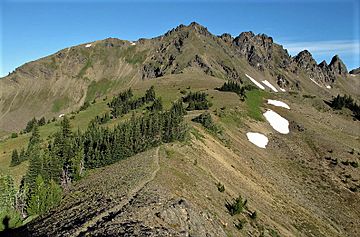Ladies Peak facts for kids
Quick facts for kids Ladies Peak |
|
|---|---|

Sourheast aspect, from Ladies Pass
|
|
| Highest point | |
| Elevation | 7,708 ft (2,349 m) |
| Prominence | 428 ft (130 m) |
| Isolation | 1.27 mi (2.04 km) |
| Parent peak | Snowgrass Mountain (7,993 ft) |
| Geography | |
| Location | Chelan County Washington state, U.S. |
| Parent range | Chiwaukum Mountains Wenatchee Mountains Cascade Range |
| Topo map | USGS Chiwaukum Mountains |
| Climbing | |
| Easiest route | Icicle Ridge Trail (#1570) + hiking the Southeast Ridge from Ladies Pass |
Ladies Peak is a mountain in Washington state. It stands tall at about 7,708-foot (2,349-metre). It's located in Chelan County, near Leavenworth. This peak is part of the beautiful Alpine Lakes Wilderness, managed by the Okanogan-Wenatchee National Forest.
Ladies Peak belongs to the Chiwaukum Mountains, which are part of the larger Cascade Range. Its closest taller neighbor is Snowgrass Mountain, about 1.27 mi (2.04 km) north. Another nearby peak, Cape Horn, is about 0.9 mi (1.4 km) to the southeast. Water from Ladies Peak flows into Icicle Creek on the west side and Chiwaukum Creek on the east. Both of these creeks eventually join the Wenatchee River. Even though it's not the tallest mountain, Ladies Peak rises dramatically over 4,700 feet (1,433 meters) above the Icicle Creek Valley in just two miles. This peak doesn't have an official name, but it's called Ladies Peak because of the nearby Ladies Pass. Many places in this area were named by Albert Hale Sylvester.
Understanding the Weather at Ladies Peak
Most of the weather we experience starts over the Pacific Ocean. These weather systems then travel east towards the Cascade Mountains. As they get closer, the tall peaks of the Cascades force the air upwards. This process, called orographic lift, makes the air cool down and drop its moisture. This is why the Cascades get a lot of rain and snow, especially in winter.
During the winter months, the weather is often cloudy. However, in the summer, high-pressure systems over the Pacific Ocean become stronger. This often leads to clear skies and sunshine. The best time to visit or climb Ladies Peak is usually from June through October. This is when the weather is most pleasant for outdoor activities.
How Ladies Peak Was Formed
The Alpine Lakes Wilderness is known for its rugged and dramatic landscape. You can see sharp peaks, long ridges, deep valleys carved by glaciers, and granite rock walls. There are also over 700 mountain lakes scattered throughout the area. All these amazing features were created by geological events that happened millions of years ago. These events caused big changes in the land's elevation and led to different climates across the Cascade Range.
About two million years ago, during the Pleistocene period, huge sheets of ice called glaciers moved across the land. These glaciers advanced and retreated many times, scraping away rock and leaving behind debris. The last time glaciers retreated from the Alpine Lakes area was about 14,000 years ago. They had moved north of the Canada–US border by 10,000 years ago. The "U"-shaped valleys you see in the rivers today are a direct result of these recent glaciers. The combination of the land being pushed upwards (called uplift) and cracks forming in the Earth's crust (called faulting), along with the action of glaciers, has created the tall peaks and deep valleys of the Alpine Lakes Wilderness.




